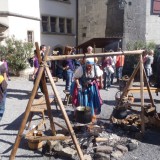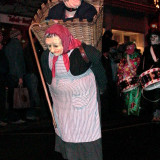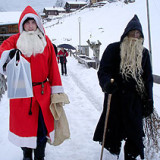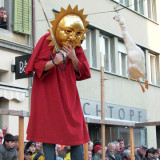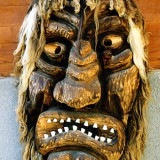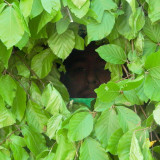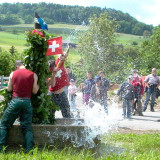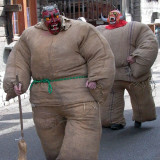Category: Switzerland
A medieval faire in a real castle!
So, I went to Switzerland in the fall and through no clever planning of my own, was in the castle town of Lenzburg on a weekend when there just happened to be a medieval faire happening. Holy. A medieval faire in a real castle?? How could I not go? Bring on the mead! The Swiss guards following me around Not too hard to escape from this jailer a “museum” room inside the castle (not necessarily medieval but cool) Not medieval but one of the “museum” rooms inside the castle a “museum” room inside the castle (not necessarily medieval but...
read moreWhere can I get one of these baskets?
Trychle, Meiringen, Canton Bern Trychle processions take place in the villages of the Hasliberg and Haslital in the week between Christmas and the New Year, mainly after dark. The masked and disguised participants make as much noise as possible with drums and cowbells. The Huttefroueli, an old woman carrying her husband in a basket on her back – known as a “Hutte” in German – is one of the stock figures of the parade. ©...
read moreSanta’s Dark Side
Why is this kid cowering in fear you ask…? Because Samichlaus is comin’ to town, that’s why. When Saint Nicholas visits schools in Switzerland fear is in the air. It’s not old Saint Nick that has them worried–it’s his helper “Black Pete”. If the kids have been good, Saint Nicholas lets them reach into his bag and take a tangerine, nuts, gingerbread, or some other treat. If they’ve been bad, that’s when Black Pete steps forward. He gathers up the bad children and puts them in a bag (sometimes the very one that Samichlaus had his treats in), then takes them away to work in the forest until next year. One year of hard labour. That’s what naughty kids get. And rumour is, the work has something to do with coal…hence “black” Pete. Naughty children in Switzerland don’t get a lump of coal in their stocking. They have to mine it. The next time your kids are complaining about their Christmas presents, click on this link and show them what they could have got. Merry Christmas...
read moreLetting it all hang out in the Swiss Alps
The BBC’s Imogen Foulkes in Geneva says naked hiking is an increasingly popular pastime in Switzerland. But (un?)fortunately those wishing to partake in this pastime will now have to pay a fine. So make sure you tuck a few bills into your socks before setting out… Read the rest at: BBC News – Swiss can ban naked hiking, court...
read moreALTDORF, a novel of The Forest Knights now available!
Buy it now at: Amazon US & Canada Amazon UK Amazon DE Amazon FR iBookstore Barnes & Noble Smashwords Go here for free e-reading apps The Forest Knights Official Website is...
read moreBeheading the goose
*Since my Forest Knights novels have a character, Seraina, who is one of the last druid priestesses, I thought it would be fun to describe some modern-day Swiss festivals with Celtic ties. So that’s what I’ll be doing in the next few posts.* Where do I start with this one? How about with the rules: Hang a dead goose by the neck in the town square Put a big sun mask on a guy with no eye slits so he is blinded Hand him a dull sword Back away quickly Each competitor gets one blind swipe at the goose with the dull blade. Kind of like a macabre “pin the tail on the donkey”. Whoever successfully decapitates the goose is declared the winner and gets to take the mangled goose home. Here’s a quote from swissworld.org just so you don’t think I’m making this stuff up! Gansabhauet, or Beheading the Goose, takes place on St Martin’s Day (November 11th). Alongside the main event are various events for children, including climbing a pole to knock down one of the presents attached to a tree at the top. The Gansabhauet itself involves blindfolded competitors using a blunt sword to attempt to...
read moreI feel like…smearing soot on young women
Canton Valais (Wallis) This is the Canton where Pirmin (a character in my Forest Knights novels) is from. If you’ve read the book, you know Pirmin is quite enamored with the opposite sex (and they with him!) so you can imagine how he would thrive in this particular festival which takes place in February: Tschäggätta in the Lötschental in Canton Valais (Wallis) (Lötschental mask© picswiss) Young unmarried men and boys roam the streets of the villages of the valley, wearing demonic masks and tunics made of sheep or goat skins, and ringing bells. The name refers to the black and white colour of these tunics: “tschäggätta” means “piebald” in the local dialect. By tradition the Tschäggätta wear gloves smeared with soot, and take the occasional swipe at anyone they meet (particularly young women). The masks are handcarved, and each one is different. They normally feature crooked teeth and bulging, uneven eyes. It is said that they reflect the untamed nature of the valley. They have also been interpreted as an expression of anarchy and rebellion in a peasant society that was largely dominated by the church. The tradition stems from the time the valley was cut off from the...
read moreBecome the tree 2: Maibär
*Since my Forest Knights novels have a character, Seraina, who is one of the last druid priestesses, I thought it would be fun to describe some modern-day Swiss festivals with Celtic ties. So that’s what I’ll be doing in the next few posts.* Maibär, Bad Ragaz, Canton St Gallen The Swiss really love to dress up as trees. Here is another festival where a guy dons a couple hundred pounds of foliage and waddles through the streets. Thankfully, after a full day of this, his costume gets thrown in the river. The Maibär festival is held on the first Sunday of May. A conical frame, which may be 4.5 m (over 14 feet) high – is covered with freshly picked foliage, and decorated with ribbons and flags. It is carried dancing through the streets of the village by a young man hidden inside it. Since the frame is so heavy – up to 100 kg (220 lb) – several bearers take it in turns. The Maibär is accompanied by youngsters with cowbells, and by a horde of children collecting money. The noise is supposed to drive away any malevolent spirits which might intend to bring back the winter. The...
read moreBecome the tree 1: Pfingstsprützlig
*Since my Forest Knights novels have a character, Seraina, who is one of the last druid priestesses, I thought it would be fun to describe some modern-day Swiss festivals with Celtic ties. So that’s what I’ll be doing in the next few posts.* Ah…the Pfingstsprützlig. I have never appreciated the copy and paste function so much. Well, if this isn’t an example of Celtic or pagan customs that are still practiced in Switzerland, I will say Pfingstsprützlig ten times after eating a box of crackers: Pfingstsprützlig, Sulz, Aargau On the afternoon of Whit Sunday – seven weeks after Easter – the young men of the Fricktal villages of Sulz and Gansingen take part in the Pfingstsprützlig, or Whitsun Water Sprite, ceremony. The sprite is dressed in leafy branches, crowned with the flags of Switzerland and Canton Aargau, and goes from trough to trough in the village, splashing water out of them. Since the branches are heavy and completely cover the sprite, in Sulz it is guided by two of its friends, who support it with a double ended paddle. When they reach a trough, the guides bend the sprite over it, and use this paddle to splash the water....
read moreEven Swiss demons are tidy
*Since my Forest Knights novels have a character, Seraina, who is one of the last druid priestesses, I thought it would be fun to describe some modern-day Swiss festivals with Celtic ties. So that’s what I’ll be doing in the next few posts.* I don’t know about you, but I really want to rent one of those inflatable Sumo wrestler suits and have a go at these guys. Mind you, they do look a little scarier than I would in a fat-man suit. The straw men, or empaillés, appear on the Sunday before Mardi Gras in the village of Evolène in the Val d’Herens. They wear baggy suits of sacking, stuffed with up to 30 kg of straw. Their faces are hidden under a carved mask, and they carry a broom. ©...
read more
